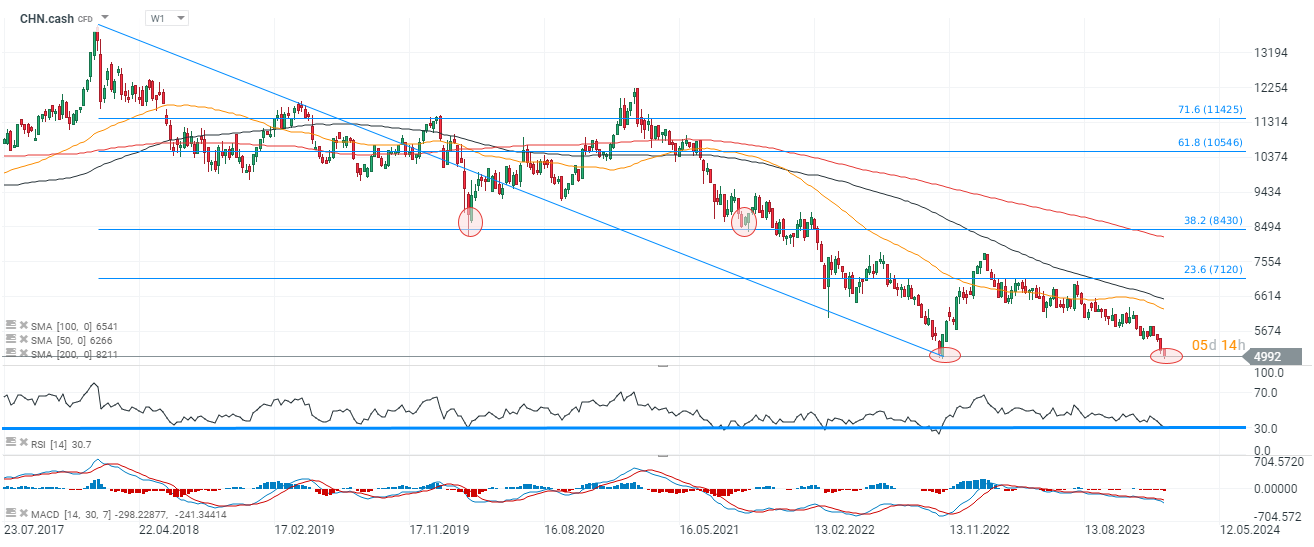Chinese indices have recorded another wave of declines, with the CHN.cash benchmark trading 3.3% lower. The benchmark approached the 2022 panic bottom at 5000 points, previously seen in 2009. The pullback in Hong Kong-listed stocks has pushed the discount to the mainland China index to its highest level in fifteen years. Investors fear this is a sign of the 'capitulation' of foreign investment capital that has flowed into companies, listed in Hong Kong, over the years. The People's Bank of China (PBoC) once again kept short- and long-term interest rates unchanged, at 3.45% and 4.25%, respectively. Investors perceived the PBoC's decision as disappointing, as China's economy is struggling with a number of problems including deflation, which according to Bloomberg analysts could last until mid-2024.
- With the central bank's 'restrictive' stance persisting for the past five months, the market fears that a significant amount of debt instruments could take on a snowball effect and plunge indebted Chinese real estate-related companies. Analysts at UBS have suggested that the modest gains from the People's Bank of China's policy loosening so far have already been priced in, and stronger programs are needed to revive indexes. Meanwhile, there is no such action from Chinese authorities on the horizon;
- A small-cap index, the CSI 500 particularly sensitive to debt and real estate market concerns, fell more than 3% today. The Asian session was once again led by the real estate development sector, which may prove to be systemically vulnerable to higher interest rate levels, with dormant demand and a significant amount of debt.
- Foreign investment in Chinese equities, at 2023, was the lowest since 2009, and the investment climate is becoming an increasingly popular reason to reduce exposure to China. China Resources Land shares were down nearly 10%. The technology sector also performed poorly, with Tencent and Alibaba deepening declines. Regulatory actions have also been questionable recently, after China's largest brokerage Citc banned short selling and raised thresholds for institutional investors. The market perceived the decision as further evidence of weakness and an attempt to stem declines.
CHN.cash chart (W1)
Looking at the weekly chart of Hang Seng futures, we see a potential double bottom formation forming at the psychological level of 5000 points. We saw a similar situation at the level of 8500 points in 2019 - 2021. Then, despite an initial bounce from 8500 points, the formation was negated and a downward wave followed. If the situation were to repeat itself, a rise to the area of 6000 points is not excluded. If this impulse were to be extinguished once again, a downward wave could potentially bring the index even to the vicinity of 2500 points. In the scenario of a 'surprise' rebound of China's indexes in 2024, the level of 7000 points, where we see the 23.6 Fibonacci retracement of the 2018 downward wave, could also prove key to watch. It is also worth noting that 2018 was a time when the conflict between Washington and Beijing began to escalate and was increasingly closely watched by the market. Source: xStation5
Source: xStation5
US Earnings Season Summary 🗽What the Latest FactSet Data Shows
3 markets to watch next week (14.11.2025)
US Open: US100 initiates rebound attempt 🗽Micron shares near ATH📈
DE40: European markets extend decline
This content has been created by XTB S.A. This service is provided by XTB S.A., with its registered office in Warsaw, at Prosta 67, 00-838 Warsaw, Poland, entered in the register of entrepreneurs of the National Court Register (Krajowy Rejestr Sądowy) conducted by District Court for the Capital City of Warsaw, XII Commercial Division of the National Court Register under KRS number 0000217580, REGON number 015803782 and Tax Identification Number (NIP) 527-24-43-955, with the fully paid up share capital in the amount of PLN 5.869.181,75. XTB S.A. conducts brokerage activities on the basis of the license granted by Polish Securities and Exchange Commission on 8th November 2005 No. DDM-M-4021-57-1/2005 and is supervised by Polish Supervision Authority.


